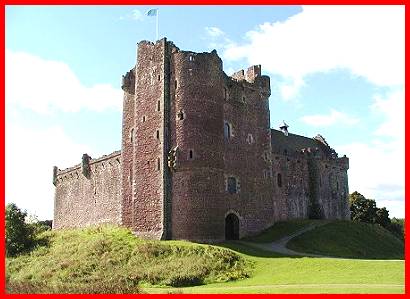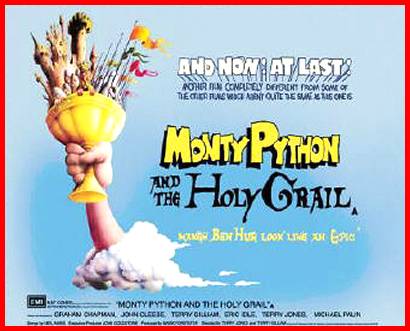![]() cenni
storici
cenni
storici
![]() Il
film Monty
Python and the Holy Grail
Il
film Monty
Python and the Holy Grail

Vedute del castello

Locandina del film

![]() clicca
sulle immagini in basso per ingrandirle
clicca
sulle immagini in basso per ingrandirle
Dal sito
www.scotlandthemovie.com: «Doune Castle appears numerous times in Monty Python and the Holy Grail notably as Camelot, the Castle of Guy de Lombard (with Trojan Rabbit), Swamp Castle where Sir Lancelot causes chaos at the wedding, and Castle Anthrax where Sir Galahad has an interesting offer! It had originally been intended to film in other locations but the Department of the Environment, which at the time looked after all castles in state care, withdrew it's permission to use it's castles two weeks before filming was due to start. Doune Castle at the time was privately owned so could be used for filming. Doune Castle is now run by Scottish Heritage the sucessor several times removed to the Department of the Envirionment. Ironically, a lot of the visitors to the castle now go there purely because of the movie connection».Dal sito www.britcastles.com: «A Baronial masterpiece; belongs to the period of the feudal barons before the age of the lairds with their tower-houses; has TWO great halls (one for the nobility, one for the retainers); a must-see. Given that there was both a retainers' hall and a baronial hall, the kitchen area was provided with several huge fireplaces (big enough to roast an ox in). The castle defenses apart from very thick walls are not that impressive, but still, outward-facing windows are very rare and there are plenty of gun loops. Doune Castle is named for a dun, meaning fortified town, which stood nearby. Doune was the Highland center for pistol making. There are traces of prehistoric earthworks around this stone castle. This iteration of the castle was built as a hunting lodge for Robert Stewart, Duke of Albany, who was the Regent of Scotland from 1396-1420. Much of the castle has been restored in recent centuries, but it is still one of the least changed castles in Scotland. Albany died in 1420, and his son, Murdoch, inherited the castle. He didn't have it for long, though. He was put to death by James I in 1425, and for more than a century, Doune Castle was held by the Crown. It finally passed to the Morays. Doune was later used as a hunting seat by James II and a dower house for Mary of Gueldres, Margaret of Denmark, and Margaret Tudor, the consorts of James II,III,IV. In 1570, Doune was being held for the exiled Mary, Queen of Scots. Montrose occupied Doune in 1645; in 1689, the government of William III garrisoned the castle against covenanters. Finally, the castle was seized by the Jacobites in 1745 and used as a prison. The castle was roofless by 1800 but restored later in the century».
Dal sito www.frii.com: «A small gargoyle drainspout. Many dot the castle walls. Doune is perhaps best known as the castle in the Monty Python and the Holy Grail movie. The caretaker told us that every year, hundreds of fans come to the castle. Doune Castle lies between a tributary burn and the Teith River, and has probably been the site of a castle since the Romans built a fort nearby to control this waterway. The surrounding earthworks are earlier, but apart from minor repairs, the stonework is all 1390 - 1420. When we arrived, they were repointing the walls for the first time in the history of the castle. The tower itself is irregularly shaped. The upper levels were secure private residences, and the Lord's Hall was a tremendous vaulted room. The fireplace at one end is unusual. Doune is shaped like an irregular pentagon. On the west, a building breaks the angle between two of the sides. The front of the castle is a thick-walled rectangular block. The east is a gatehouse tower, which is an impressive 95' tall and probably was taller at one time in it's history. The entrance passes through the rectangle at a slant, and is protected by arrow loops. It had a portcullis at one time. The kitchen of Doune is equally impressive. The fireplace is the full width of the lobby. There is no opening to the cellars, which are only reached from the courtyard. This is unusual, and must have made storage difficult? However, in the middle of the courtyard is a deep 60' well, usually containing 10' of water».
Dal sito www.scotland2000.com: «Standing on a strong site in a lovely location, Doune Castle, built in the 14th century, consists of two strong towers linked by a lower range. These buildings form two sides of a courtyard, the other sides enclosed by a high curtain wall. The fine Lord's Hall has a carved oak screen, musician's gallery and a double fireplace. The castle was built by Robert Stewart, Duke of Albany, who virtually ruled Scotland during the reign of Robert III and the imprisonment in England of the young James I. When Albany died in 1420, his son, Murdoch, succeeded him as Regent, but when James I was freed in 1424 he had Murdoch executed. Doune was kept as a royal hunting lodge, prison, and dower house for the widows of James III, James IV and James V. It was occasionally used by Mary, Queen of Scots, and was held by forces loyal to her until 1570. Doune was occupied by the Marquis of Montrose in 1645, and by Government troops during the Jacobite Risings of 1689 and 1715. It was taken by Jacobites in 1745, and used as a prison, although many of the prisoners escaped. Doune was restored in the late 19th century, and was used as a location for the BBC production of Ivanhoe».
Dal sito wald.heim.at: «Ende des 14. Jahrhunderts ließ sich Robert Stewart, der Duke of Albany, diese Burg bauen. Er war der Bruder des damaligen schottischen König Robert III. Sein Sohn Murdoch erbte die Burg 1420 und übernahm die Regentschaft in Schottland, weil der schottische König Jakob I. in englischer Gefangenschaft war. In dieser Zeit fiel das Land in Anarchie. 1425 kehrte Jakob I. nach Schottland zurück und ließ Murdoch und seine Söhne auf Dune Castle festnehmen und wegen Hochverrats hinrichten. Dune wurde beschlagnahmt und diente bestenfalls als Übernachtungsstätte für müde Könige. Bonnie Prince Charlie machte die Burg 1746 vorübergehend zum Kriegsgefangenenlager. Danach stand die Burg lange Zeit leer. Der 14. Earl of Moray begann Ende des 19. Jahrhunderts mit der Restaurierung der Burg und erneuerte die Parkanlagen».
Dal sito www.perthshire-scotland.co.uk: «This impressive fortress of Doune Castle was built in the late 14thC by Robert Stewart, Duke of Albany, who effectively ruled Scotland during the reign of Robert III and while James I was imprisoned in England. Upon Robert Stewart's death in 1420 his son Murdoch suceeded him as Regent. King James was freed in 1424 and had Murdoch executed and his lands were confiscated. The castle became a Royal hunting lodge. In 1528 it was given back to the descendant of Albany and from him to the earls of Moray who still own the property. Mary Queen of Scots used the castle and forces loyal to her held the castle until 1570. It was occupied by Montrose in 1646 and by Williamite forces in 1689. During the Jacobite rebellion of 1715 government forces held Doune. However, in the 1745 it was taken by the Jacobites of Bonnie Prince Charlie and used as a prison. The castle featured in the cult comedy movie Monty Python and the Holy Grail».